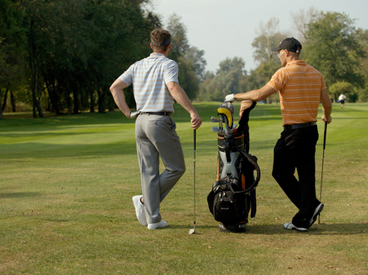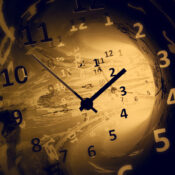I was never what you’d call a good friend of Drew Claringbold. We were acquaintances mostly, occasional golfing buddies. Like most members of the Duffin’s Bay Golf & Country Club, what I knew best about him was his swing. His superb swing. When I was a teenager hanging out at the club and looking for caddy jobs, I would inevitably wander over to the practice tee if Claringbold was there hitting balls. On rare occasions, I’d be the only spectator present, but most of the time there’d be at least six or seven golfers watching him hit a wonderful low draw, his magnificent high fade, punch shots, slow risers, lobs. He could work the ball just about any way he wanted. I’m sure we all thought if we observed him long and hard enough, we’d walk away with the magic formula that would make our swings as fluid as his. In my case, it never happened, and let’s leave it at that.
Drew Claringbold was simply the best golfer at the Duffin’s Bay Golf & Country Club. It may not sound like much, but consider that he was 11 times the club champion, four times runner-up, and five times its senior champion. The belief around the clubhouse was that if his game was clicking, the tournament was pretty much settled before he reached the back nine. What prevented Claringbold from winning every year was consistency. Claringbold, so blessed with a swing for the ages, was also cursed with an uncertain putting stroke. He wasn’t a bad putter, just an unpredictable one.
When he was rolling the ball smoothly, confidently, he was unbeatable, and those who were with him the day he set the course record of 60 (on a par 72), swore up and down they had never seen a player putt it better. Claringbold fired at the flag all day and only a few unlucky bounces kept him from being inside eight feet on every hole. On the rare occasions he was 20 feet or more away, he holed each putt as if it were a tap in.
“Yeah, it was a pretty good day out there,” was all Claringbold said afterward as he bought drinks for his three playing partners and a few hangers-on who had walked with him from about the 14th hole, when word reached the clubhouse that he was on a birdie tear.
But that was just one magnificent day in a long, spectacular career.
None of the Duffin’s Bay old-timers could remember a time when Claringbold didn’t have that swing. Those in the know, and with a few connections, said Claringbold’s swing rivaled Ben Hogan’s. That both had tapped into some great golfing secret that only a select few had ever done. Among the stories I heard at Duffin’s 19th hole was that Claringbold had played with the great Hogan a few times and had never lost by more than a couple of strokes. One story floating around was that he even beat the grand master one autumn day in a friendly match in Texas some 50 years ago. Claringbold never confirmed it, but a faint smile would escape his lips when anyone ever brought it up.
He was a lawyer by trade and a damn good one according to most. I saw him try a couple of cases and recall the grace with which he walked around the courtroom, his lithe figure moved first to the witness, then back to his desk, then over to the jury. He showed intense concentration as he pored over his notes or deconstructed a story that didn’t quite fit the scenario. The demands of his profession, however, never got in the way of squeezing in his four or five rounds a week. Such are the perks of the small-town lawyer.
Once, when I still had the callowness and bravery of someone shy of 20, I asked Claringbold, with deepest respect in my voice, why he hadn’t pursued a professional golfing career. He looked at me quizzically, as if no one had ever posed the question, and then stared out toward one of the fairways for what seemed like such a long time that I thought maybe he hadn’t heard me. But I stayed patient and imagined he was replaying some great shot in his mind before giving an answer. Finally, he looked back at me and with a shrug and said, “I guess I loved the law more.”
Then he walked away, head bent and shoulders slouched, as if he regretted his answer and his life choice.
Despite his accomplishments on the links, and the awe he inspired in all of us Duffin’s Bay golf groupies, there was one nemesis to Claringbold’s game, besides the aforementioned putting. To the astonishment of everyone, Claringbold had never been able to birdie the 10th hole. According to sources better than I, he had birdied every other hole countless times and eagled about half of them. But the 10th remained unattainable.
What made this remarkable was that the opening hole of the closing nine was far from being the club’s toughest. Running almost straight for 465 yards to a fairly generous green, the 10th was the type of hole that needed two solid, but not spectacular, shots, followed by a good putt for birdie. A few poplars, spruce, and maples hugged the right side to separate it from the par-5 first hole, and a couple of shallow bunkers protected the green on either side. But beyond a few bushes at the back, there was nothing too challenging for a good golfer, let alone a great one, to overcome.
Still, Claringbold couldn’t birdie it.
Even when he was playing his best, he could only summon par. There was no explaining it really. His woods and irons were so true that he rarely missed the green in two swings. But somehow he could never get it down from there. Twenty feet, 12 feet, eight feet, five feet. Regardless of how far his ball was from the hole, his putter would desert him. Once when I was older and playing with him, he stuck his second shot 18 inches from the flag. I didn’t dare say anything in case it jinxed him, but I could barely contain the thought that I’d be there when he finally birdied the 10th. But when he hit his putt, the stroke was just slightly fast and the ball lipped out.
“Damn this hole,” he said, in what was probably the strongest language he had ever used.
In later years, when he had retired from law, Claringbold would spend almost all his days at Duffin’s Bay. On some evenings just before the sun would set, he’d head for the 10th hole just to play it and nothing else. Sometimes he’d hit a couple of balls to increase the odds. Drew knew that a birdie under such circumstances wouldn’t count, but he had to prove to himself it could be done. Even with the rules of golf loosened, he couldn’t notch the elusive bird.
It was strange and unexplainable. Here was a guy who routinely birdied, and a few times eagled, the par-4 seventh, easily the toughest hole on the course—a landing area that was maybe 25 yards wide and 250 yards uphill from the small tee. Hit it too far left or right and you were in the woods. Hit it short of the landing area, as most of us did, and you were fighting a blind, uphill second shot at best, or else enduring the slow agony of watching your ball roll downhill to a flat spot that was maybe 100 yards from the tee.
We all cursed the seventh.
Once, when I was caddying for Claringbold, he smacked a lovely drive on the seventh. It pierced the slight wind and landed at what looked to be 275 yards dead center. When we got there no ball was seen. I walked around in circles for several minutes and finally noticed a 7-iron someone must have forgotten lying on the fairway at about the 270-yard mark. Acting on a hunch, I headed into the woods on the right, and there was his ball, dead behind a couple of birch trees in thick grass. No shot.
Incredibly bad luck. Claringbold grunted disapproval, but otherwise seemed unfazed. He looked at his shot, saw that he couldn’t go straight for the green, and asked me to walk across to the left woods to “keep an eye on this one.” I’m sure what happened next was planned. He took a 4-wood from his bag; made a short, punchy swing; and popped the ball almost straight left, watched it carom a tree near where I was standing, and saw it bounce on the green. One putt, 18 feet, for his third stroke.
He didn’t say anything until the eighth tee where he pulled out his card and pencil (he didn’t like caddies keeping his score) and muttered “routine birdie.” We all cracked up. He then took out the 7-iron we’d found on the seventh, teed his ball about 180 yards from the par-3 flag, and swung. Knocked it in for an ace before he tossed the club in the garbage can.
Geez, the guy was amazing. Except at the 10th.
When he was in his late 70s, Claringbold was in a minor car accident, which reduced some of his mobility. He still had the swing, but age and injury had reduced its power. He played occasionally for a year or two after, but he was eventually relegated to sitting in the clubhouse to watch others play the game he loved and excelled at. Ironically–he’d say unfortunately–the main clubhouse window overlooked the 10th tee.
Every so often I’d see him staring out that window and shaking his head. “I could birdie that hole,” I heard him once mutter. “I could.”
One evening in late summer, I walked off the ninth into the clubhouse and saw him finishing up his dinner. He looked up and smiled.
“How’s the score today?” he asked.
“Not bad today, Drew. I’m five over.”
“Pretty good… for you.” And he chuckled. “You going to fit in the back nine?”
“Naahhh, not enough time.”
He stood up, slowly. “Come on, a group just went off. You could do it.”
He stared at me, not saying anything, but something made me say what I hadn’t even considered for the past couple of years. “Tell you what. I’ll play the 10th and come back on the 18th if you come with me.”
“Sure,” he said, without hesitation.
“And play, too.”
That stopped him momentarily. He looked first at me, then the 10th hole, then back at me. There was just a hint of a smile. “Of course, my clubs aren’t here. They’re in the trunk of my car.” Who knows why he kept them there, long after his playing days were over.
“Really? Well, give me the keys and I’ll get them for you.”
Claringbold seemed to be doing everything in slow motion, even talking. “All right,” he said quietly. “Yeah, let’s do it. I’ll meet you on the tee.”
He moved sluggishly in an awkward shuffle, but didn’t change his mind. I went to get his clubs and took my time, knowing it would take him awhile to reach the 10th. When I got there, he was sitting on a bench, pale and weak looking.
“You sure you’re up for this, Drew?”
He coughed violently for a moment, and then stood up. “Yes, yes, I’m all right. Damn congestion, that’s all. Hand me the driver, please.”
Something about golf invigorates a person. Perhaps it’s the notion of being outside with nature, breathing the air, the quiet hum of a summer evening. But as he took his club, he appeared to shake off 20 years of age, standing tall once again and looking as if he had never left the game. Watching him take his backswing was like seeing him again through 18-year-old eyes. For a man in his condition, he simply smoked it. It landed about 220 yards out and rolled another 25 dead center.
“Not bad for an old geezer,” he said.
For one of the few times in my life, I outdrove him, but at that point I didn’t care. I was getting one more chance to play with Drew Claringbold, and he was still showing me a thing or two. He had his clubs on a pull cart, but was breathing hard when we reached his ball. He waved off any suggestion that we stop and rest. “I’m feeling OK,” he said, but the words came out languidly between breaths. He was sitting about 220 yards from the flag, and I suspect that the drive took so much out of him that there was no chance he could go for the green. Claringbold thought otherwise. “Hand me the driver again, please. I think I’ve got a pretty good lie.”
There are those that’ll tell you they were there the day Drew Claringbold hit his second shot with a driver on the 10th. They’ll rhyme off details about the wind conditions, the lie, the grace of his swing—even what he was wearing that evening. But I know it was just the two of us out there in the middle of the fairway, the sun low on the horizon. When the club connected with the ball, I followed its flight, knowing he’d hit a good one. It just sailed, and for a moment, I had the feeling it might never come down. But a sound nearby interrupted, and I looked back to where he had been standing.
I like to think that before he crumpled in a heap some 245 yards out on the 10th fairway, Drew Claringbold, before he drew in his last breath, had also watched that sweet second shot of his. I like to think he looked intently as it hit the front of the green, took a couple of bounces, and started rolling. And I also like to think that the expression on his face, as he lay there on the ground, was one of pleasure rather than some final grimace of pain more likely to accompany a sudden heart attack. I just don’t know.
What I do know is that throughout his long, marvelous golfing life, Drew Claringbold, the finest man I ever had the chance to play the game with, never birdied the 10th hole at the Duffin’s Bay Golf and Country Club. But I’ll never forget the last shot he hit and how it rolled smoothly toward the hole, before dropping into the cup.
For an eagle.
Become a Saturday Evening Post member and enjoy unlimited access. Subscribe now





Comments
Great story, Mark with just the right amount of satire — as only you could do.
I loved the story. I’ve only ever had 6 golf lessons, but I worked this summer with a young guy who
played every chance he got and dreamed of playing every other waking minute. So I understand the passion for the game.
A gripping golf yarn! Great piece. I would love to see the character of Drew Claringbold fleshed out into a novel.